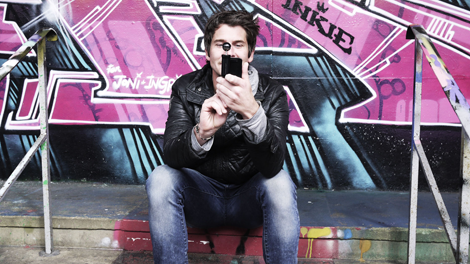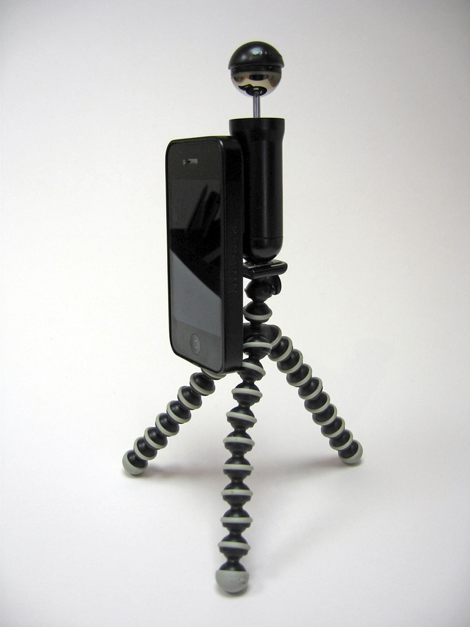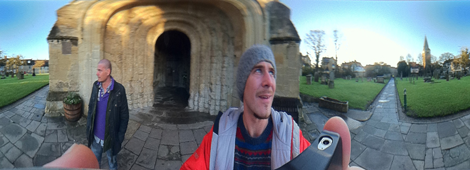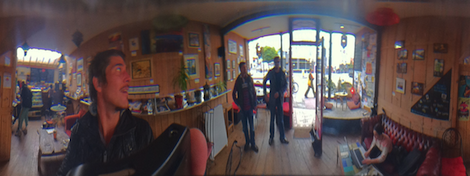
According to our analytics, the iPhone user base accounts for a massive majority of our readership. There’s something about designers and engineers that love themselves a bit of Appley-rectangle stroking, you know? A project that grabbed my interest this last week came from British industrial designer, Tom Lawton and the BubbleScope project. Keen to learn more about the project, how the team are building not only a physical product, but a community around it, I shot Tom some questions over:
Al Dean: So Tom, What’s your background?
Tom Lawton: I’ve always been into making stuff and have a keen eye for the visual arts. That led me to take a degree in Product Design & Visualisation at Bournemouth University in 1994. While studying I spent a year working in Real Time 3D simulation for a VR firm in Cape Town – we built simulations of new towns for architects to fly through. I got to use a SGI Onyx Reality Engine 2 (a serious piece of kit in 1996) and so I could see the awesome potential of Real Time 3D graphics as a tool. When I graduated a couple of years later I had an inventive fire burning, so while continuing to work in 3D CAD over the following decade as a freelancer, I focussed much of my effort towards making my own product innovations a reality. I had success really early on in my career with my invention WakeYoo, the recordable alarm clock, which launched in 2000 and went on to sell over 250k units. From there I’ve just kept it up – if you’ve ever sat with me in the pub you’ll know I’m not short of ideas.

AD: Where did the idea for BubbleScope come from?
TL: As much as I love digital tools, I prefer the real world. In 2001 I was travelling in India (I was actually on a 56 hour train journey) when inspiration struck. I very contentedly witnessed the most amazing sunset mountain view from the open doorway between one of the carriages – and because we were moving – it was impossible to create a stitched panorama that worked – more so, I wanted to capture the complete 360° bubble , including me and the 40 or so other people crammed into the train doorway. I imagined being able to shoot the bubble instantly (somehow?) and in that moment share it with someone somewhere else. The idea was all about story telling in VR bubbles – I knew about creating QTVR images with scanned or digital photos and also from 3D CG scenes but I wanted to take it to the next level. So I decided to set upon a self initiated R&D project to develop a compact and affordable instant 360° imaging device. After several years of effort I am thrilled to present the elegantly simple BubbleScope.
AD: You’ve spilled some of the beans about how you’re building a sharing community resource around the hardware product. I’m guessing some sort of app. How much of a challenge is that, to not only bring a physical product to market, but now you’ve got software development, community building, to achieve to get the whole ball rolling?
TL: It’s been a real challenge – developing just a piece of hardware is a big job on it’s own. I don’t think I’d have started doing all this if I knew quite how much of a mission it was going to be. But the three elements to BubbleScope (the product, the App ‘BubblePix’ and the community BubblePix.com) are all essential to the whole customer experience and over the course of time, together with my commercial director & business partner Peter Corke of the Ketchup Group, I have developed a strong and technically competent team, including a very proficient group of App & web developers, key technical & optical designers, creative marketing guys, back office and commercial folk. The way we’ve built the business is scalable too – if the market demands then we’ll be able to supply through a premium distribution/manufacturing channel we have lined up. The project is unique – it’s totally British (although volume manufacturing will take place in Shenzhen, China) – the product has awesome potential and I guess that it has attracted good minds to it. We’ve had to crack some very complex nuts on the real time visualisation (RTV) system in the App but our lead developers have been making immersive 360 on mobiles since 2005 so I can confidently say I have found best of class individuals.

AD: What’s it like developing hardware/software for the iPhone? Any tips?
TL: We’re not just developing for iPhone. The way we’ve developed the RTV and the opto-mechanical arrangement of the scope means we can integrate with pretty much any major smartphone – this has been a primary intention throughout – obviously you need an App for the device and also a device specific phone case to interface the hardware together – the scope lines-up with the camera on your phone. So we’re concurrently developing the Apps for iOS and Android with Windows Mobile to follow. To launch we’re focussing on the iPhone 4 for the phone case – others in the autumn when we have an idea of volume & demand, but the App will be free from launch for all devices. We’ve done our best to future-proof the design for when you upgrade your phone so that the scope doesn’t become immediately obsolete – you just buy a new case to match it up.
In terms of challenges, the iPhone has its own idiosyncrasies that we’ve had to accommodate – mainly to do with the camera. But we haven’t compromised in the vision we set out on – compact, affordable, high-quality instant 360 imaging – both high res stills and video – the product uses only precision engineered glass optics to reflect the best quality of light back into the camera and the way our RTV works means the whole 360 scene can be previewed on the screen instantly – it’s a panoramic viewfinder. My tip would be to find a team of App guys who you know have a degree of specialism in the prime technology/functionality used in your App. That might sound obvious but there are a lot of companies out there in this space and you could spend a great deal of $$ taking a long time to get it right – we interviewed several upon dozens of recommendations. Also, don’t assume you have to resource a team in London – yes, there are many awesome companies there but that’s true of most major UK cities. The other main business partner working with us in BubblePix is Stuart Varrall who runs Fluid Pixel Studios, who are our App development team. Fluid is part of a growing hub of very creative digital companies based in Newcastle.

AD: You’re pushing the project through Crowdfunder.co.uk. I know KickStarter gets all the press with these types of projects – which sucks massively for those of us outside of the US (Kickstarter will only handle US-based projects). Why go down that route in the first place?
TL: We’re aware of some of the product successes on Kickstarter and as a British start-up we wanted to find a similar way to engage with future users of BubbleScope – in order to gain insight from the way they use the product to help craft the way we grow the community and develop future Apps & products. So we’re asking people to pledge their support to us so we can increase our initial production volume – in return we offer a 25% discount on the product and the exclusivity of being one of the first to get one. High profile beta testers already include Jamie Oliver, the Gadget Show’s Suzi Perry and Jamie Cullum – who are all keen social photographers. The challenge of course is that few people outside of a small circle know about Crowdfunder.co.uk and so I would request that your readers take a look (and pledge their support to BubbleScope of course). We need our own platform like Kickstarter for British product innovation – maybe this is it? What made Kickstarter so good was a few great projects supported by a strong crowd – there’s no reason we can’t have the same here.
In recent months and also through Kickstarter we have seen two competitive products appear in the iPhone 360 video space, both are inferior in terms of interoperability, function, optical specification and product design – but equally, they would not have come about if it wasn’t for the springboard that Kickstarter gave them. Crowdfunding is a powerful tool – the question is, will the UK embrace its own version – I hope so for the sake of home-grown creative projects.

AD: We’ve talked offline about the potential to use this as a visual guide for those doing rendering work. That fascinates me. Capture a basic HDR with your telephone, pump it into something like KeyShot and you’ve got a mini-Spheron (for those unaware, Spheron cameras are used to capture those HDR images you pay a crap tonne of cash for online). Think that’s got legs?
TL: Possibly, yes. You’ll never replace the quality that you’re going to get with a Spheron (in terms of sheer resolution and optical clarity) but for certain situations I can see where it would be a valuable tool. The restriction is really based on what image the camera can output, HDR images are a specific format where exposure info can be extracted – the iPhone 4 shoots an HDR image in two consecutive frames but then automatically composes them together as a jpeg. We may look to extract these images before they are composed and provide an importable HDR file – but whether we integrate this type of feature into our App depends much on what feedback our beta testers provide to us – if there’s a need, we’ll do it. The same is true of using the scope to blend two images and produce a full 360 x 180 spherical panorama (as opposed to 360 x 120 degrees with the scope). I imagine it would be awesome for 360 video too – especially because of the compact nature of smartphone + scope – you could get all sorts of POV. Of course, you’d want to use the product on a tripod and auto timer to avoid any artefacts (e.g. you) – but that wouldn’t stop you strapping it to a skateboard.
AD: Is there a danger that you’re spilling the beans on your idea before you’ve built a customer base, distribution channel by taking things public?
TL: I don’t think so. Our ducks are all lined up now – if we have a successful launch then we already have a leading distribution channel in place that will open up retail globally – sure, there are always risks with copycats from unscrupulous companies out there. But it’s quite a complicated product technology to get right and we have international patents pending – with no prior art identified through international searches, so we can claim rights to this space and we will do all that we can within our power to maintain our intellectual property rights. They key to mass adoption of BubbleScope will be the sharing of bubbles – the social aspect of them – we figured there was little point launching a product without a means of hosting images & video – and our web services will just plug in to Facebook & Twitter etc. All that and a little bit of endorsement from some high profile users and we’ll be set to go. Exciting times ahead.
AD: Any tips for anyone else with a smart idea that’s looking at the Crowdfunded route?
TL: On the basis that I assume your readers are not American then I’d recommend finding the best Crowdfunding site you can (there’s a bunch cropping up right now) but in reality, the best will be the one that has the biggest crowd. Make sure you are as ready as you possibly can be. Years of effort have gone into our preparation before making a public pitch – we can deliver on our promise as the product is way more than a concept. Be prepared to make some noise for your own pitch. We’ve been sending press releases, emailing bloggers and have been on full assault spreading the word in person, socially etc.
AD: Can I have one please?
TL: Sure, what phone do you use and I’ll send a case to match it up.
If you fancy diving in on this, have your iPhone 4 at the ready, the Crowdfunder project page is here and funding closes in the next month or so and you can get in on the action first. Finally, here’s Tom’s pitch. Full of geeky goodness and more than a homage to the Fast Show. Brilliant!






